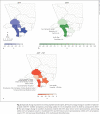COVID-19 Impact on Acute Ischemic Stroke Treatment at 9 Comprehensive Stroke Centers across Los Angeles
- PMID: 34175851
- PMCID: PMC8339042
- DOI: 10.1159/000516908
COVID-19 Impact on Acute Ischemic Stroke Treatment at 9 Comprehensive Stroke Centers across Los Angeles
Abstract
Objective: To describe the impact of COVID-19 on acute cerebrovascular disease care across 9 comprehensive stroke centers throughout Los Angeles County (LAC).
Methods: Volume of emergency stroke code activations, patient characteristics, stroke severity, reperfusion rates, treatment times, and outcomes from February 1 to April 30, 2020, were compared against the same time period in 2019. Demographic data were provided by each participating institution.
Results: There was a 17.3% decrease in stroke code activations across LAC in 2020 compared to 2019 (1,786 vs. 2,159, respectively, χ2 goodness of fit test p < 0.0001) across 9 participating comprehensive stroke centers. Patients who did not receive any reperfusion therapy decreased by 16.6% in 2020 (1,527) compared to 2019 (1,832). Patients who received only intravenous thrombolytic (IVT) therapy decreased by 31.8% (107 vs. 157). Patients who received only mechanical thrombectomy (MT) increased by 3% (102 vs. 99). Patients who received both IVT and MT decreased by 31.8% (45 vs. 66). Recanalization treatment times in 2020 were comparable to 2019. CSCs serving a higher proportion of Latinx populations in the eastern parts of LAC experienced a higher incidence of MT in 2020 compared to 2019. Mild increase in stroke severity was seen in 2020 compared to 2019 (8.95 vs. 8.23, p = 0.046). A higher percentage of patients were discharged home in 2020 compared to 2019 (59.5 vs. 56.1%, p = 0.034), a lower percentage of patients were discharged to skilled nursing facility (16.1 vs. 20.7%, p = 0.0004), and a higher percentage of patients expired (8.6 vs. 6.3%, p = 0.008).
Conclusion: LAC saw a decrease in overall stroke code activations in 2020 compared to 2019. Reperfusion treatment times remained comparable to prepandemic metrics. There has been an increase in severe stroke incidence and higher volume of thrombectomy treatments in Latinx communities within LAC during the pandemic of 2020. More patients were discharged home, less patients discharged to skilled nursing facilities, and more patients expired in 2020, compared to the same time frame in 2019.
Keywords: COVID; Door-to-groin puncture time; Door-to-needle time; Ischemic stroke; Los Angeles; Reperfusion; Treatment.
© 2021 S. Karger AG, Basel.
Conflict of interest statement
Jason W. Tarpley, MD, is a consultant for Medtronic − Modest. Otherwise, the authors have no conflicts of interest to declare.
Figures


References
-
- AHA/ASA Stroke Council Leadership Temporary emergency guidance to US stroke centers during the COVID-19 pandemic. Stroke. 2020;51((6)):1910. - PubMed

